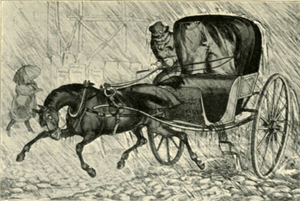Cabriolet (carriage)
A cabriolet is a light horse-drawn vehicle, with two wheels and a single horse. The carriage has a folding hood that can cover its two occupants, one of whom is the driver. It has a large rigid apron, upward-curving shafts, and usually a rear platform between the C springs for a groom. The design was developed in France in the eighteenth century and quickly replaced the heavier hackney carriage as the vehicle for hire of choice in Paris and London.
.jpg)

Cabriolet with retracted hood in a mise en scène at Wilfred Rotte's farm in Saint-Jérôme, Quebec, c. 1906.

A cab on the slippery London cobblestones in 1823. The curtain in front of the passengers has been drawn because of the pouring rain. The groom is unprotected.
The cab of taxi-cab or "hansom cab" is a shortening of cabriolet.[1]
Other horse-drawn cabs include:
- Araba or aroba: used in Turkey and neighboring countries
- Araña: Mexican, two-wheeled
- Bounder: four-wheeled
- Gharry or gharri: used especially in India
- Kalesa or calesa (sometimes called a karitela): used in the Philippines
- Dorożka in eastern Europe
- Minibus: light carriage, usually with a rear door and seats for four passengers; formerly used as a cab
- Two-wheeler: two-wheeled cab or hansom
One who drives a horse-drawn cab for hire is a cabdriver.[2]
See also
- Hansom cab
- Cabriolet (automobile)
- Types of carriages
References
- "At about ten o'clock in the evening I drove with Mr Eastlake, in a cab (the usual name given here to a cabriolet), to the British Institution..." (Gustav Waagen, Works of Art and Artists in England vol. I [1838], extract in Frank Herrmann, The English as Collectors 1972, p. 227).
- "Cabdriver. The American Heritage Dictionary of the English Language: Fourth Edition. 2000". Archived from the original on 2005-04-21. Retrieved 2008-01-07.
This article is issued from Wikipedia. The text is licensed under Creative Commons - Attribution - Sharealike. Additional terms may apply for the media files.